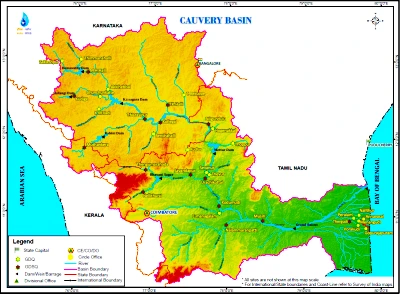Context:
The National Green Tribunal (NGT) has issued notices to the governments of Karnataka, Tamil Nadu, and Kerala following a report by the Indian Institute of Science (IISC) over a reduction of green cover in the Cauvery basin.
NGT Expresses Concerns Over Cauvery Basin Deforestation
- Concerns over Decrease in Forest Cover: The NGT has expressed concerns about the extensive agricultural and horticultural activities in 73.5% of the Cauvery basin.
- Only 18% of the area remains as forested areas and dense forests are confined to a mere 13% of the region.
- Need for Urgent Action: The NGT has emphasized the need for urgent action to address the environmental challenges in the Cauvery Valley and protect its ecosystems.
- The states in question have been urged to respond to the NGT promptly, and the case is scheduled to be heard at the Chennai bench of the Tribunal, which holds jurisdiction over the matter.
Cauvery Basin Lost Nearly 12850 Sq. Km of Green Cover
- Decline in Green Cover: The Cauvery Basin has witnessed a reduction of 12,850 square kilometers (sq km) of green cover from 1965 to 2016.
- Karnataka has lost around 57 percent of the green cover, equivalent to 9,664 sq km, Tamil Nadu has witnessed a loss of 29 percent (2,905 sq km) and Kerala has lost 27 percent (279 sq km) of its green cover during the same period.
- Decrease in Forest Cover in Natural Reserves: The expansion of agricultural activities and mining and development projects has exacerbated the pressures on the natural reserves.
- Bandipur National Park: The forest area in the park has decreased by 15.19% over the past 50 years, mainly due to development activities and forest fires.
- Nagarhole National Park: It has witnessed an 11% reduction in forest cover due to human intervention and heightened horticulture activities.
- Biligiri Ranganathaswamy Temple (BRT) Wildlife Sanctuary: It has experienced a reduction in forest cover, prompting concerns regarding forest encroachment.
- Cauvery Wildlife Sanctuary: It faces a threat to its forested areas due to population growth and encroachment, resulting in an 18.43 per cent reduction in greenery between 1973 and 2016.
- Bannerghatta National Park: It has seen a significant decline in dense forest cover, to 28 per cent in 2016 from 50.40 percent in 1973.
About Cauvery Basin
- Basin States: The basin spreads over the states of Tamil Nadu, Karnataka, Kerala and the Union Territory of Puducherry which is nearly 2.7% of the country’s total geographical area.
- Area: It extends over an area of 85,626.23 sq. km with a maximum length and width of 560 km and 245 km, respectively.

Cauvery Basin Map
- Geographical Boundaries: It is bounded by the Western Ghats on the west, by the Eastern Ghats on the east & the south and by the ridges separating it from Krishna basin and Pennar basin on the north.
- Source: Cauvery River which is the main river in this basin rises at Talakaveri on the Brahmagiri range in the Western Ghats in Karnataka at an elevation of about 1341 m and flows for about 800 km before its outfall into the Bay of Bengal.
- Tributaries of Cauvery River: The important tributaries joining the Cauvery are Harangi, Hemavathi, Kabini, Suvarnavathi and Bhavani.
Reasons Behind Cauvery Basin’s Green Cover Lost
- Root Cause: According to the ecologists, large dams disrupt water flow and sediment transport.
- Deforestation in the Western Ghats: According to a study by IIT-Bombay, deforestation in the Western Ghats(WG) is depleting water resources in water scarce regions, such as Tamil Nadu.
- The WG, acknowledged as a biodiversity hotspot, has witnessed a 35% decline of green cover since 1920 due to expansion of plantations, agriculture, and the demand for hydropower dams.
- Disruption in Rainfall Patterns: According to a study published in the journal Geophysical Research Letters in 2018, this ecological deterioration has disrupted the fundamental patterns of rainfall and decreased the strength of monsoons, leaving behind dry and arid lands.
- Western Ghats are responsible for 25% to 40% of Tamil Nadu’s monsoon precipitation between June and September which sustains vital Kharif crops.
- Rise in Temperatures: The disappearance of trees led to a 0.25-degree Celsius rise in surface temperature across Tamil Nadu.
- Deforestation exposes bare land, allowing more sunlight to heat the earth, triggering increased evaporation and impeding moisture accumulation.
About Biodiversity Hotspots
To qualify as biodiversity hotspot, an area must meet two strict criteria:
- Contains at least 1,500 species of vascular plants found nowhere else on Earth (known as “endemic” species).
- Have lost at least 70 percent of its primary native vegetation.
Biodiversity Hotspots in India
- Himalaya: Includes the entire Indian Himalayan region (and that falling in Pakistan, Tibet, Nepal, Bhutan, China and Myanmar)
- Indo-Burma: Includes entire North-eastern India, except Assam and Andaman group of Islands (and Myanmar, Thailand, Vietnam, Laos, Cambodia and southern China)
- Sundaland: Includes Nicobar group of Islands (and Indonesia, Malaysia, Singapore, Brunei, Philippines)
- Western Ghats and Sri Lanka: Includes entire Western Ghats (and Sri Lanka)
|
About National Green Tribunal (NGT):
- It was established in 2010 under the NGT 2010 for effective and expeditious disposal of environmental protection and conservation cases.
- It is a specialized body equipped with the necessary expertise to handle environmental disputes involving multi-disciplinary issues.
- The Tribunal is not bound by the procedure laid down under the Code of Civil Procedure, 1908, but guided by principles of natural justice.
Benches of National Green Tribunal (NGT):
- Principal Bench: New Delhi
- Regional Benches: Bhopal, Pune, Kolkata and Chennai
|
Also Refer: Protected Areas, Biosphere Reserve, National Park
News Source: DTE
![]() 17 Jan 2024
17 Jan 2024

